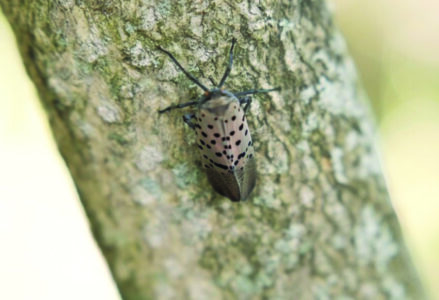Severe winter storms impact area forests

JOHN PEPIN
“By the dark of the moon I planted, but there came an early snow.” — Michael Martin Murphey/Larry Cansler
The arched green cathedral ceiling of the forest was awash in white, with freshly fallen snow covering everything from the red pines to the blueberry bushes that were buried deep beneath winter’s cold, frosty blanket.
There was evidence all around that the pair of fierce winter storms that ravaged the region had been severe. The easterly winds had packed snow hard against the entire length of tree trunks and plastered hollows shut.
Even the narrowest branches had a covering of at least a couple of inches of snow.
The woods were almost devoid of animal signs, except for some deer tracks trailing away through the deep snow and the faint voices of chickadees dee-a-dee-deeing off in the background somewhere.
Branches weighed down with heavy wet snow and frozen sleet and rain were bent over almost completely, like wet reeds softened and shaped to fashion a basket.
Many boughs had shattered and splintered. In some places, entire trees had been forced by the strong gusting winds to bend and then break, crashing tremendously to the ground.
The snow covering the landscape was soft but so very deep for walking, even along the forest paths.
As I trudged along noticing these things I stopped.
Still.
That’s when I saw the forest for the trees. These woods were enchanted, sublime in the beauty the winter queen had brought here.
I stood humbly within an ice-blue fortress of magnificent beauty. This was like a magnificent snow palace.
There were towering white pillars covered in alabaster, tremendous great rooms with vaulted ceilings and thrones and other furniture, including marble benches, tables and shelves. There were decorative sculpted, artful statuettes and silent obelisks.
In the wake of the storms the wind was as soft as a whisper. The profound quiet seemed to be enhanced by the presence of the snow, as though the covering over everything had muffled or deadened anything moving that would make a sound.
With the snow so soft, my footfalls barely made any noise at all.
When moments of these kind occur, I know it’s time to stop doing anything – just stop everything. Stand. Close my eyes and lean back into a deep breath of fresh air. The cleansing inside is magnificent.
I felt like I was right in sync with the season, which is comforting.
Often, I find I’m dragging behind the changes, or way out ahead of myself, wishing the days away until the next summery season appears on the horizon.
Though it sounds plainly obvious, I’m learning that natural actions like the seasons changing move and happen in their own time, not mine or anybody else’s. I think that’s one of those truths that hides itself in plain sight in the broad light of day.
Discovering it is deeper than it appears on the surface, like the slow, still waters inundating the cattails, rounding the bend in the river and heading downstream.
A few days prior to this, I traveled south to the haunt of one of my heroes — John Ira Bellaire, the man who arranged for the sale of 90 acres to the state of Michigan by the Palms Book Land Co. of Detroit — preserving for posterity what we know today as Kitch-iti-kipi, the Big Spring at Palms Book State Park.
The day I visited “The Mirror of Heaven” it was in glorious spirits. The cedars surrounding the oval-shaped pool of always open water were covered in snow.
Forty feet deep, the spring casts an eerie and bewitching glow of emerald green.
Big lake trout — retired from the state’s hatchery runways — move through the depths, clearly visible above soft sands churned by the water bubbling from beneath cracks in the limestone bottom.
In many cases, the fish appear to be hovering, almost motionless in the water, like dark submarines waiting silent and deep. In other instances, the gigantic trout crash wildly through the surface of the water, suddenly splashing at the top, a tremendous event to witness.
A viewing raft, in place for decades, remains operational during the wintertime.
The spring on the day I was there bore no resemblance to the way Bellaire found it when he first visited in the early 1920s. He discovered the site as nothing more than a dark hole hidden in a tangle of trees, a place lumbering companies had dumped trash.
Into his 70s, Bellaire visited the spring almost daily to sit quietly, discovering introspection and peace in the glassy waters of the reflecting pool.
Around 1930, Bellaire operated a five-and-dime store in Manistique where he sold water and sand from the spring, promoting them as “magical.” The sand was said to be called “Juggler’s Sand” by the Indians and the water, “Juggler’s Laughing Rain.”
According to the packets containing them, the sand and water from Kitch-iti-kipi are used thus: “The sand as an all-around good luck powder, and the water as a prevention against Bad Spirits. The sand, when mixed with a kind of bark the Indians smoked, becomes Takosavos, ‘Love Powder.'”
On the ride home, the snow from the big snowstorms — along with skies still flying squadrons of dark blue billowy clouds broken up by amber rays of sunlight — presented countless magnificent scenes across the white-veiled landscapes be they wetlands, hillsides, forests or fields.
At home, the storms had claimed at least one big maple and a trio of cedars that had stood guard along the west side of the driveway. Here too, the heavy snow and whipping winds were no match for these old souls.
The maple is still resting on the roof of the garage, the cedars are sleeping in pieces beneath the snow, below the sheltering arms of their compatriots, many of which remain standing, slumped and snowbound.
The nights have been silent since the big storms, softly letting loneliness sift down over these snow-covered houses and streets. There’s something dead about that kind of quiet – something furtive and strange.
It doesn’t feel right, unnerving.
The snow bears the imprint of turkey’s wings and feet after gliding into the fluff from one of the big trees at the back of the property. Blue light imbues the shadows around the bases of the apple trees.
I look up to see the stars, but they’re not there. Instead pale ghost clouds fly on by, like bed sheets stretched and billowing across the nighttime skies.
Contorted and conflicted, I’m like some of the gnarled trees in these wondrous snow castle places here on earth. I keep moving ahead dazzled and discovering, wondering what’s around the next corner.
Editor’s note: John Pepin is the deputy public information officer for the Michigan Department of Natural Resources. Outdoors North is a weekly column produced by the Michigan Department of Natural Resources on a wide range of topics important to those who enjoy and appreciate Michigan’s world-class natural resources of the Upper Peninsula. Send correspondence to pepinj@michigan.gov or 1990 U.S. 41 South, Marquette, MI 49855.




